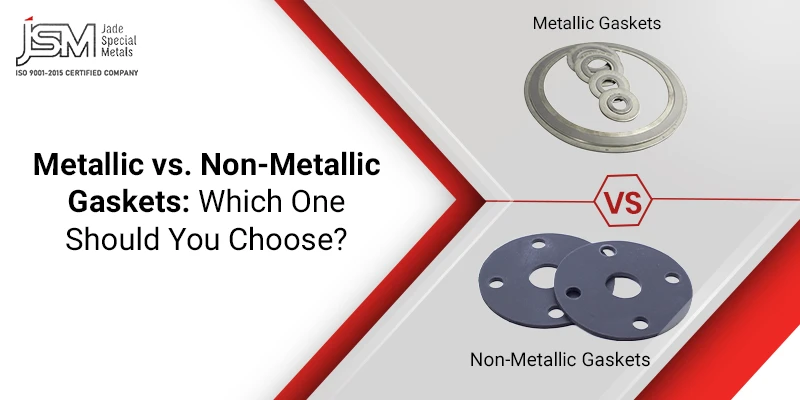In industrial operations, the choice of a gasket is not a minor detail; it’s a critical engineering decision that directly impacts safety, reliability, and operational efficiency. A gasket’s primary role is to create a secure seal between mating surfaces, preventing leaks of liquids or gases under varying pressures and temperatures. In sectors like oil & gas, petrochemicals, marine engineering, and power generation, gasket failure can cause unplanned shutdowns, costly repairs, environmental hazards and even safety incidents.
Every application provides a unique challenge; extreme heat in steam lines, aggressive chemicals in process plants or corrosive seawater in offshore applications. Selecting the correct gasket must be a balance of several factors – pressure class, temperature range, chemical compatibility, the condition of the flange faces, and maintenance schedules. The gasket must also adhere to or exceed the requirement of standards such as ASME B16.20, EN 13555 or API 6A.
With over 20 years of experience supplying high-performance sealing technology, Jade Special Metals is a single source for metallic, non-metallic and semi-metallic bespoke gaskets for global industrial applications. Our technical support, mill-certified materials, and just-in-time supply chain help our customers globally reduce the threats of the high cost of downtime and achieve sustainable sealing reliability. If you think gasket selection is a last-minute option; we believe it is a strategic choice!
What is a Gasket and Why It’s Critical?
A gasket is an element that serves to seal two surfaces together in an assembly, blocking the flow of fluids or gases from the joint. The main purpose of a gasket is to seal by creating a tight, leak-proof fit, but even when using gaskets, most surfaces will not be perfectly flat. A properly designed and installed gasket will account for joint imperfections, and seal effectively. Other considerations in gasket design are to ensure that the gaskets remain intact and are not blown out during conditions of high pressure or temperature, and that they minimize the amount of vibration and noise in mechanical systems – think of the applications involving pumps and compressors.
- Flange Surface Finish – The sealing performance depends on the smoothness and texture of the flange face; rough or uneven finishes require specific gasket designs to maintain a leak-tight seal.
- Bolt Load – Adequate and uniform bolt tightening is critical to compress the gasket material evenly, ensuring consistent sealing pressure across the joint.
- Gasket Material Compatibility – The gasket must resist chemical attack from the process media to prevent degradation, swelling, or embrittlement during service.
- Long-Term Creep Resistance – Gaskets should maintain their shape and sealing force over time, even under constant pressure and temperature cycling, to avoid premature leaks.
By addressing these factors, engineers ensure operational safety, regulatory compliance, and extended equipment life, all of which make gasket selection a key part of plant reliability strategy.
Types of Gaskets by Material Composition
Metallic Gaskets
Metallic gaskets are typically made of metals or metal alloys. They are suitable for Class 600 and higher pressure ratings and are capable of temperatures above 1000°C. Metallic gaskets are typically used in critical service applications where a gasket blowout or leak could have catastrophic effects.
Non-metallic gaskets
Non-metallic gaskets are made from softer materials like PTFE, rubber, graphite, and CNAF. These gaskets perform well in low to medium pressure applications, and since non-metallic gaskets are compressible, they require less bolt load on flange designs with weaker flanges or where assemblies would be regularly disassembled for maintenance.
Semi-metallic gaskets
These combine both the strength of metals and the sealing benefits of many non-metallic fillers. These gaskets are used when service conditions exceed non-metallic limits, but a fully metallic gasket is not required or preferred. They are a good balance of serviceability and versatility.
Deep Dive: Metallic Gaskets
Metallic gaskets are composed entirely from a single metal or a combination of different metals allowing for sealing capabilities superior to many non-metallic gaskets. Designed for medium -high pressure applications, they have outstanding temperature resistance, mechanical load resistance and chemical environments.
Common Materials & Products:
- Soft Iron RTJ Gasket – Metallic gaskets are composed entirely from a single metal or a combination of different metals allowing for sealing capabilities superior to many non-metallic gaskets. Designed for medium -high pressure applications, they have outstanding temperature resistance, mechanical load resistance and chemical environments.
- Nickel Plug Gasket – Made from commercially pure nickel with excellent resistance to caustic soda, chlorine, and other very corrosive chemicals, widely used in chlor-alkali and chemical processing plants.
- Stainless Steel Plug Gaskets – Made from SS 304 or SS 316 to give very good corrosion resistance, mechanical strength and compatibility with a variety of industrial fluids and mild chemicals.
- Duplex RTJ Gaskets / Super Duplex RTJ Gaskets – High strength alloys with excellent chloride stress corrosion cracking resistance suited for offshore, marine, and desalination projects.
- Rubber Coated RTJ Gaskets – Metallic core and elastomer coating for improved flange protection, seal improvement and minimize damage to the flange face during installation or removal.
- Stainless Steel RTJ Gaskets – Machined from SS 304 or SS 316, these gaskets deliver excellent corrosion resistance and strength. Ideal for high-pressure, high-temperature flange joints in oil & gas, petrochemical, and power generation systems.
Applications of Metallic Gaskets
- Oil & Gas Industry – Used in refinery piping, subsea wellheads, and high-pressure transmission lines where extreme temperatures and pressures demand a secure, leak-proof seal.
- Petrochemical Plants – Ideal for reactors, heat exchangers, and process vessels handling aggressive chemicals and superheated steam under continuous operation.
- Marine Engineering – Applied in ship engine exhaust systems, seawater pipelines, and offshore platforms, offering corrosion resistance in saltwater environments.
- Power Generation – Used in steam turbines, condensers, and boiler systems where they maintain sealing integrity under thermal cycling and high-pressure steam.
Pros and Cons
| Advantages | Limitations |
| Easy to install and replace | Limited temperature and pressure tolerance |
| Lower cost compared to metallic | Shorter lifespan in harsh conditions |
| Good adaptability to flange imperfections | Not reusable |
| Wide chemical compatibility (depending on material) | Possible creep or relaxation over time |
Comparison Table: Metallic vs Non-Metallic Gaskets
Before the comparison, it’s important to understand that performance depends on the operating environment. The table below summarizes the key performance factors.
| Factor | Metallic Gaskets | Non-Metallic Gaskets |
| Temperature Resistance | Up to 1000°C+ depending on alloy | Typically up to 300°C |
| Pressure Ratings | Very high (Class 900–2500) | Low to medium (Class 150–300) |
| Chemical Compatibility | Excellent with proper alloy selection | Good but limited by material type |
| Reusability | Often reusable if undamaged | Generally single-use |
| Bolt Load & Installation | Requires high bolt load, precise alignment | Low bolt load, easier to install |
| Cost & Lifecycle | Higher cost, long lifespan | Lower cost, shorter lifespan |
Key Factors for Choosing the Right Gasket
Gaskets may be tiny components, but they play a crucial role in equipment and system operations. As selecting the wrong gasket configuration or material can impact operational reliability, great care should be taken during the design and material selection process. Be sure to partner with a trusted supplier who will be able to carefully evaluate your specific needs and guide you throughout every step of the process.
- Temperature Resistance – Use a gasket material that can include a temperature range capable of containing the maximum operating temperature of the system without losing sealing capability. Metallic gaskets are suited for temperatures over 1000°C, whereas most non metallic gasket options are suitable for temperatures under approximately 300°C.
- Pressure Ratings – Ensure the gasket corresponds to the pressure class of the system. Failure to do so may result in blowouts or leaks. A metallic option, such as an RTJ gasket, is appropriate for the range of Class 900 – 2500. On the other hand, non-metallic options are appropriate for lower pressure classes.
- Chemical Compatibility – Confirm that the gasket material can withstand the process fluid or gas. Nickel Plug Gaskets can resist caustic chemicals, while PTFE is suitable for highly corrosive acids and solvents.
- Reusability – Metallic gaskets can potentially be reused if they haven’t been damaged and not damaged, which can prolong their life potentially reducing long-term cost. Non-metallic gaskets can usually be used only once because they typically deform or have a compression set.
- Bolt Load & Installation – Most metallic gaskets require more extensive bolt loads as well a precise alignment of the pipe flanges. Non-metallic gaskets seal with relatively low force and compression
- Cost & Life-Cycle – The purchase price is an important consideration, but other factors like maintenance scheduled, and its impact if stuck downtime should also be considered. A more expensive metallic gasket can often mean you do not have to replace it or maintain it as often, so although it might cost more upfront, it might end up costing you less.
Case Scenarios
- Steam Lines – Use Soft Iron RTJ Gaskets for sealing high-pressure and high-temperature steam in power plants and industrial boilers. Their ductility ensures a tight fit under heavy bolt loads, preventing leakage over prolonged service cycles.
- Chlor-Alkali Plants – Use Nickel Plug Gaskets for handling caustic soda, chlorine, and other aggressive chemicals. Nickel’s exceptional corrosion resistance ensures reliability and safety in harsh chemical processing conditions.
- Offshore Platforms – Use Super Duplex RTJ Gaskets in marine and chloride-rich environments such as oil rigs and subsea equipment. They offer outstanding strength and resistance to pitting, crevice corrosion, and stress cracking.
- HVAC Systems – Use Rubber Gaskets for sealing joints in air ducts, chilled water lines, and ventilation systems. Their flexibility allows easy installation and excellent sealing in low-pressure applications.
- Chemical Reactors – Use PTFE or Graphite Gaskets for superior chemical resistance and thermal stability. These materials maintain sealing integrity in corrosive environments and during frequent thermal cycling.
Spotlight: Semi-Metallic Gaskets as a Hybrid Solution
Semi-metallic gaskets combine metal for strength and non-metallic fillers for sealing adaptability. They bridge the gap where pure metallic or non-metallic options may fall short.
Examples:
- Spiral Wound Gaskets – Built with alternating layers of metal windings and soft filler material, offering a perfect balance of strength and flexibility. Ideal for high-pressure and high-temperature applications where thermal cycling is common.
- Kammprofile Gaskets – Feature a serrated metal core with soft sealing layers such as graphite or PTFE. They deliver excellent sealing performance on imperfect flanges while maintaining structural stability under varying loads.
Metal Jacketed Gaskets – Consist of a soft filler encased in a thin metal jacket, combining resilience with a robust outer layer. Commonly used in heat exchangers, valves, and applications requiring thermal and mechanical protection.
Gasket Standards & Certifications to Know
- BeforeASME B16.20 / B16.21 – Specifies dimensions, materials, and performance requirements for metallic and non-metallic gaskets used in piping flanges. Ensures interchangeability and compliance across global industrial projects.
- EN 13555 – Defines testing procedures to determine gasket characteristics under various loads, temperatures, and media. Helps engineers select the right gasket material based on accurate performance data.
- API 6A / 17D – Covers design and material requirements for gaskets used in wellhead and subsea equipment in the oil and gas industry. Ensures sealing reliability in high-pressure, offshore, and safety-critical environments.
Conclusion – Which Gasket Should You Choose?
When your application is demanding (high pressure, high temperature, and/or aggressive media) you can trust metallic gaskets. If your application is price sensitive and/or moderate in nature, non-metallic gaskets are an effective solution. If you aren’t specifically looking for durability or flexibility, semi-metallic gaskets often fit this role. Jade Special Metals can provide the full range of gaskets from Soft Iron RTJ Gaskets to PTFE and Graphite Gaskets with global sourcing, ASTM specification quality, and just-in-time delivery.






